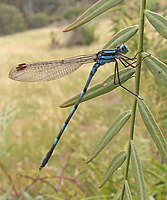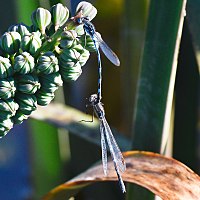
The red-veined darter or nomad is a dragonfly of the genus Sympetrum.
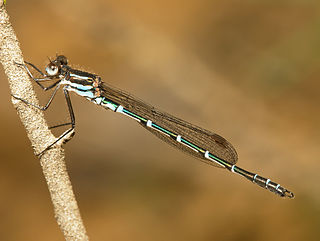
The metallic ringtail is an Australian damselfly in the family Lestidae, It is widely distributed in Tasmania, Victoria and eastern New South Wales. It is a thin, medium-sized damselfly with a green and gold or bluish green and gold coloration. Each abdominal segment is marked by a pale "ring"; this, combined with its glossy metallic coloration, give it its common name of metallic ringtail.
Ringtail, ring tail, or ring-tail may refer to:

The red and blue damsel is a damselfly in the family Coenagrionidae. It is the only member of the monotypic genus Xanthagrion.

The common flatwing is a very common species of damselfly of the subfamily Argiolestinae in the family Megapodagrionidae. It is also known as an Australian flatwing.

The orange threadtail or ochre threadtail is an Australian damselfly in the family Platycnemididae. They are medium-sized with a length of around 35mm. Orange threadtails can be found near semi-shaded running water, and usually rest on plants at the water's edge. Orange threadtails may be seen all year round. In Victoria they occur at lower altitudes during summer, though further north they can be seen in spring and autumn. When at rest, Nososticta damselflies hold their wings closely folded up vertically over their thorax. The male threadtails have an orange-yellow thorax with black patterns. Their abdomen is narrow, black in colour with yellow strips. There is a brown yellow colour at the base of their wings. Females are the same size as the males. They are pale brown in colour and have the same black patterns as the males.

The slender ringtail is an Australian damselfly in the family Lestidae. It is characterized by having a relatively slender body compared to other species in the genus.

Austrolestes colensonis, commonly known as the blue damselfly, is a species of damselfly of the family Lestidae. It is endemic to New Zealand and can commonly be found throughout the country, and at any time of the year. It is New Zealand's largest damselfly, and only blue odonate.
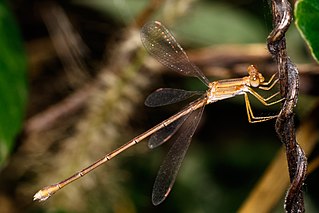
Lestes concinnus is a species of damselfly in the family Lestidae, the spreadwings. They are so named because they rest with their wings spread. This species is known commonly as the dusky spreadwing. It is a nomadic damselfly found in India, Southeast Asia as far as New Caledonia, and northern parts of Australia.

Argiocnemis rubescens is a species of damselfly in the family Coenagrionidae, commonly known as the red-tipped shadefly. It is a widespread species extending from India to southern China, south-east Asia, New Guinea and Australia.
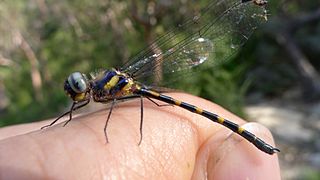
Cordulephya pygmaea is a species of dragonfly of the family Cordulephyidae, also known as the common shutwing. It inhabits streams in eastern Australia. It is small to tiny in size, coloured black, or purplish-black, with yellowish markings. It rests with its wings folded above its body in a similar manner to a damselfly.
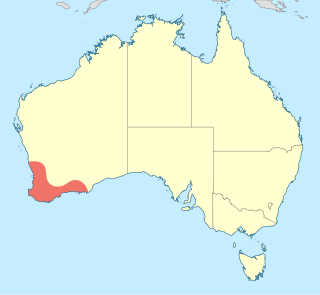
Austrolestes aleison is an Australian species of damselfly in the family Lestidae, commonly known as a western ringtail. It is endemic to south-western Australia, where it inhabits pools, ponds and lakes.

Austrolestes aridus is an Australian species of damselfly in the family Lestidae, commonly known as an inland ringtail. It is widespread across inland Australia, where it inhabits streams, pools, and ponds.
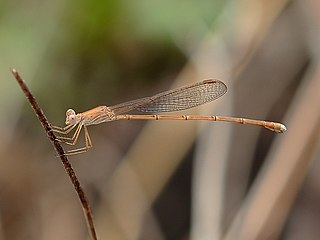
Austrolestes insularis is an Australian species of damselfly in the family Lestidae, commonly known as a northern ringtail. It is widespread across northern Australia, where it inhabits streams, pools, and ponds.
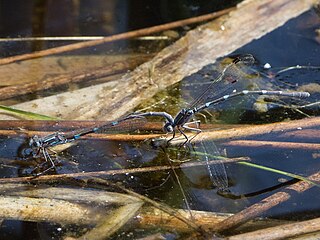
Austrolestes io is an Australian species of damselfly in the family Lestidae, commonly known as an iota ringtail. It has been found in both south-western Australia as well as south-eastern Australia where it inhabits pools, lakes and ponds.
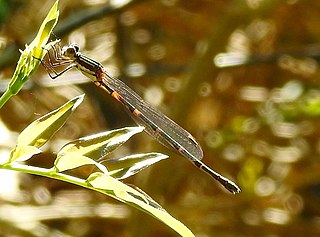
Austrolestes leda is an Australian species of damselfly in the family Lestidae, commonly known as a wandering ringtail. It is found across eastern Australia where it inhabits slow and still water.
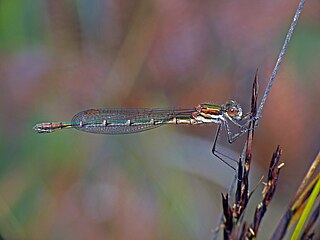
Austrolestes psyche is an Australian species of damselfly in the family Lestidae, commonly known as a cup ringtail. It is found in south-eastern Australia where it inhabits pools, lakes and swamps.

Diphlebia lestoides is a species of Australian damselfly in the family Lestoideidae, commonly known as a whitewater rockmaster. It is endemic to south-eastern Australia, where it inhabits streams and rivers.

Griseargiolestes griseus is a species of Australian damselfly in the family Megapodagrionidae, commonly known as a grey flatwing. It is endemic to south-eastern New South Wales, where it inhabits bogs and seepages near small streams.

Synlestes weyersii is a species of Australian damselfly in the family Synlestidae, commonly known as a bronze needle. It is endemic to south-eastern Australia, where it inhabits streams and rivers.




